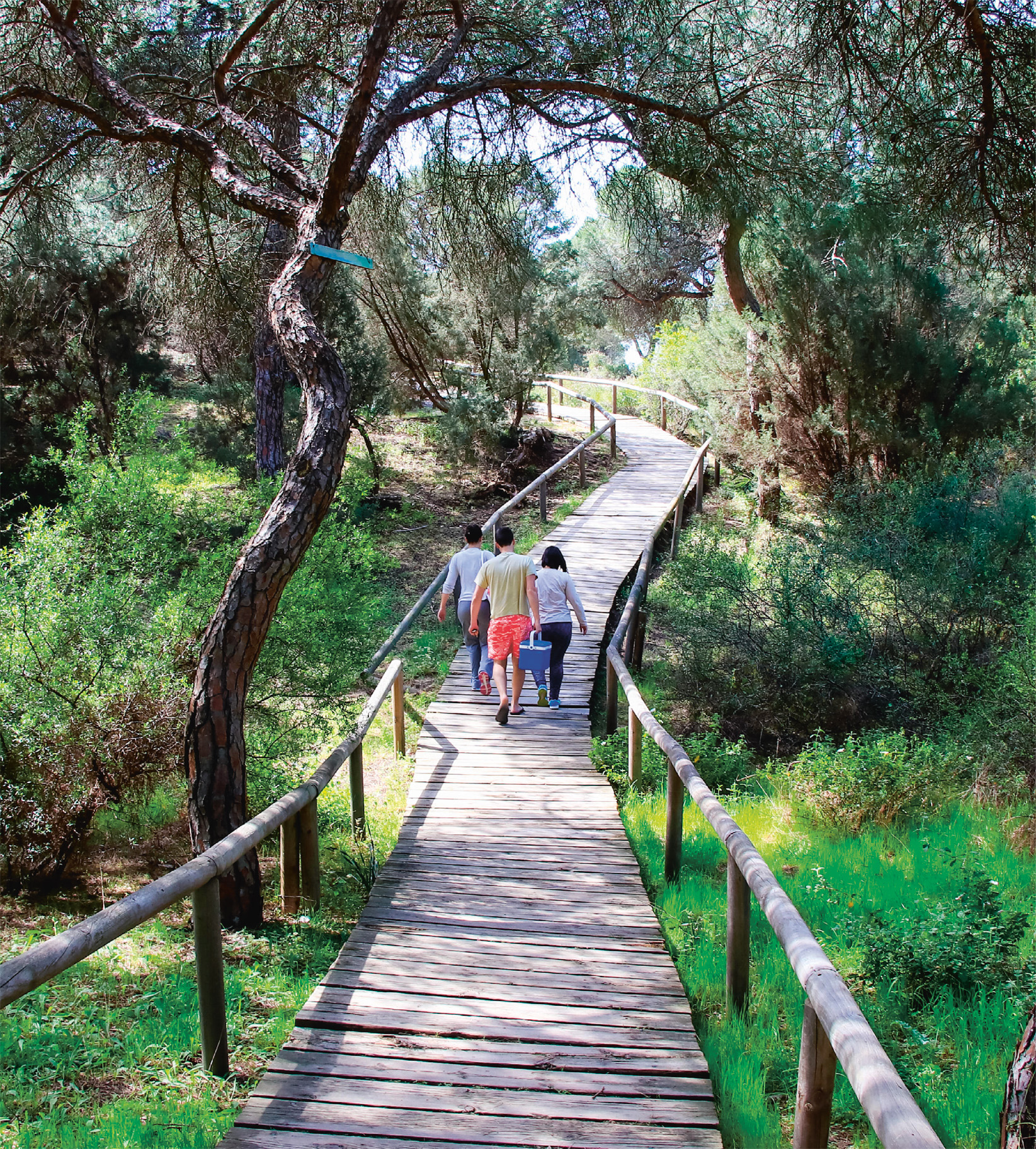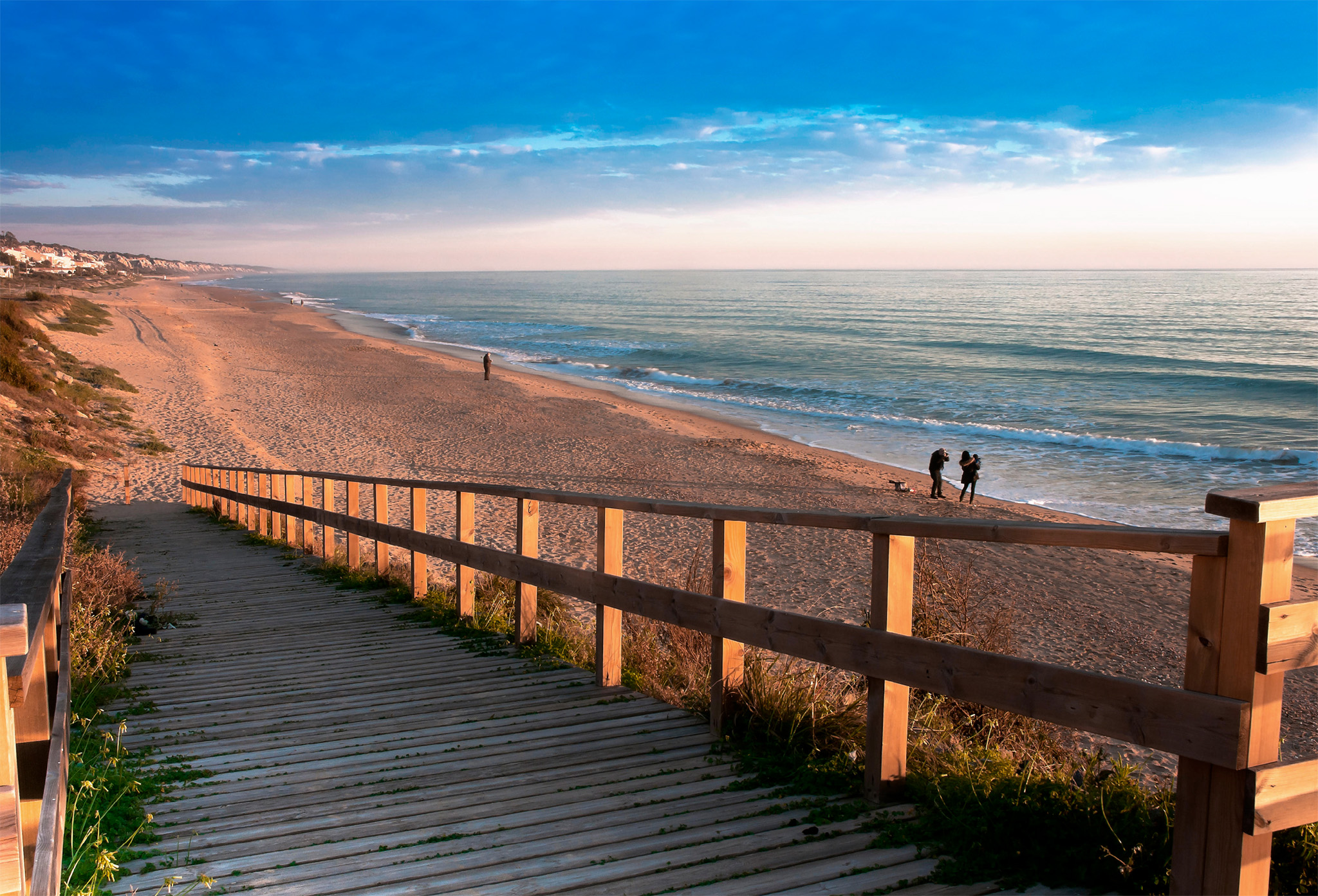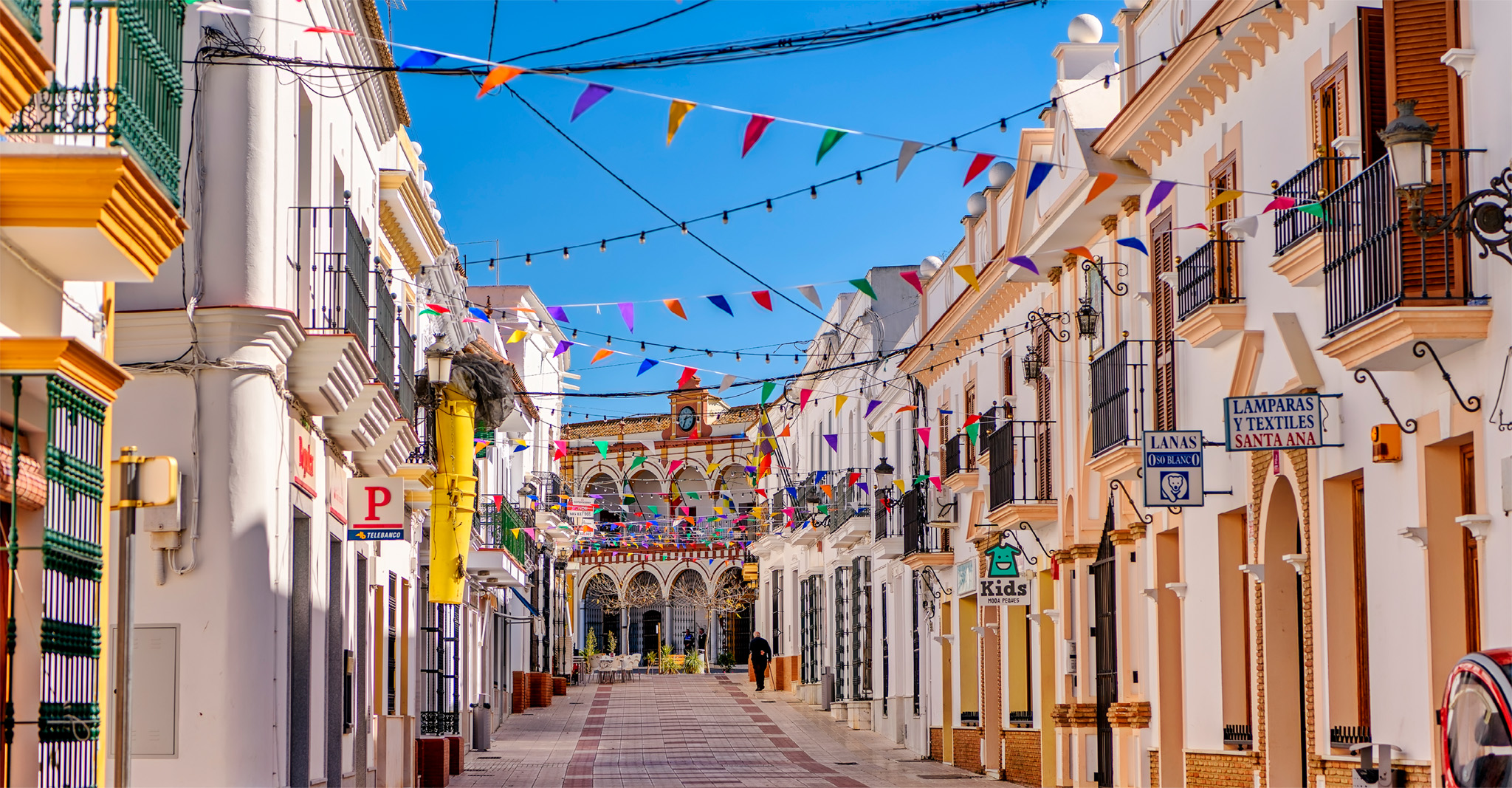
t The Emerald Lake in the Gruta de las Maravillas, Sierra de Aracena
Once a distinct island, Isla Cristina is now surrounded by marshes. Situated near the mouth of the Guadiana river, it is an important fishing port, home to a fleet of tuna and sardine trawlers. With a fine sandy beach, Isla Cristina is also a popular summer resort. Situated along the main seafront is an excellent choice of restaurants, which serve delicious, freshly landed fish and seafood.
NASA uses the extreme acid environment of Riotinto to simulate conditions on Mars.
Experience Huelva and Sevilla
|
EAT Casa Rufino Our favourite Isla Cristina restaurant. ⌂ Avenida de la Playa s/n, Isla Cristina ∑ restauranterufino.com ¡¡¡ LPA The Culinary Bar Tantalizing seafood in Ayamonte. ⌂ Plaza la Lota 10, Ayamonte § 633 66 76 03 ¢ Mon ¡¡¡ Restaurante Tapas Jesús Carrión Regional cuisine is given a twist at this Aracena eatery. ⌂ Calle Pozo de la Nieve 35, Aracena ∑ jesuscarrionrestaurante.com ¡¡¡ |
A fascinating detour off the N435 between Huelva and the Sierra de Aracena leads to the opencast mines at Riotinto. These have been excavated since Phoenician times; the Greeks, Romans and Visigoths exploited their reserves of iron, copper, silver and mineral ores.
From the lip of the crater, the trucks at work in the mines appear toy-sized. The Museo Minero in the village explains the history of the mines and of the Rio Tinto company. At weekends and on public holidays there is a train tour in restored 1900 carriages.
' "
⌂ Plaza del Museo # 10:30am–3pm & 4–7pm daily ¢ 1 & 6 Jan, 25 Dec ∑ parquemineroderiotinto.es

t The Emerald Lake in the Gruta de las Maravillas, Sierra de Aracena
This wild mountain range in northern Huelva province is one of the most remote and least visited corners of Andalucía. Its slopes, covered with cork, oak, chestnut and wild olive, are cut by rushing streams and many tortuous mountain roads. The main town here, Aracena, squats at the foot of a ruined Moorish fortress on a hillside pitted with caverns. One of these, the entrancing Gruta de las Maravillas (“Cave of Wonders”), can be entered to see its underground Emerald Lake and extraordinary stalactite and stalagmite formations.
' "
⌂ Calle Pozo de la Nieve, Aracena § 663 93 78 76 # 10am–1:30pm & 3–6pm daily
The largest beach resort in Huelva province, Punta Umbría sits at the end of a long promontory, with the Marismas del Odiel wetlands to one side and a sandy beach on the other. The Riotinto Company first developed the resort in the late 19th century for its British employees. Today, the beachside villas are popular with Spanish visitors.
A long bridge crosses the marshes, giving road access from Huelva, but it’s more fun to follow the trail blazed by Riotinto expatriates seeking the sun and take the ferry across the bird-rich wetlands.

t Shaded boardwalk leading to the beach at Punta Umbría
Founded as Onuba by the Phoenicians, Huelva had its grandest days as a Roman port. It prospered again in the early days of trade with the Americas, but Seville soon took over. Its decline culminated in 1755, when Huelva was almost wiped out by the great Lisbon earthquake. Today, industrial suburbs sprawl around the Odiel quayside, from which the Rio Tinto company once exported its products all over the commercial world.
That Columbus set sail from Palos de la Frontera, across the estuary, is Huelva’s main claim to fame. This fact is celebrated in the excellent Museo Provincial, which also has several exhibitions charting the history of Riotinto.
⌂ Alameda Sundheim 13 § 959 65 04 24 # 9am–8pm Tue–Sat, 9am–3pm Sun
Experience Huelva and Sevilla

Believing that he could reach India by sailing westwards, Christopher Columbus (below) set off in that direction from Palos de la Frontera in 1492. When he landed in the Bahamas later that same year, he believed that he had fulfilled his ambition. He made three further voyages from Andalucía, reaching mainland South America and other islands in what are still termed the West Indies in deference to his mistake.

PICTURE PERFECT
Picturesque photo ops abound at Moguer on the third weekend of February, when the townspeople dress in period clothes for Fería Moguer 1900, a festival celebrating the poet Juan Ramón Jiménez.

t Mazagón beach, irresistible for long walks along the Atlantic shore and among the sand dunes
One of the more remote beach resorts of the Costa de la Luz, Mazagón shelters among pine woods 23 km (14 miles) southeast of Huelva. Virtually deserted in winter, it comes to life in summer when mainly Spanish holiday-makers arrive to fish, sail and enjoy the huge, and often windswept, beach. Despite this seasonal influx, if you visit the resort in the summer months, you may still find some pleasure in Mazagón’s solitude, while taking long walks along the endless Atlantic shoreline and among the sand dunes.

t Moguer, a maze of pretty streets and flower-filled shady courtyards
A beautiful whitewashed town, Moguer is a delight to stroll around, exploring treasures such as the 16th-century hermitage of Nuestra Señora de Montemayor and the Neo-Classical town hall. Moguer is also the birthplace of the poet and 1956 Nobel laureate Juan Ramón Jiménez. The Museo de Zenobia y Juan Ramón Jiménez is located in his restored former home.
The walls of the 14th-century Monasterio de Santa Clara enclose some splendid, stone-carved Mudéjar cloisters. The nuns’ dormitory, kitchen and refectory capture some of the atmosphere of their life here.
" '
⌂ Calle Juan Ramón Jiménez 10 # Hours vary, check website ∑ fundacion-jrj.es
" '
⌂ Plaza de las Monjas # By guided tour only; Tue–Sun ∑ monasteriodesantaclara.com
In 1491, a dejected Genoese explorer found refuge in the Franciscan friary at La Rábida. King Fernando and Queen Isabel had refused to back his plan to sail west to the East Indies. The prior, Juan Pérez, who as the confessor of the queen had great influence, managed to get this decision reversed. The following year, this sailor, by the name of Columbus, became the first European to reach the Americas since the Vikings.
La Rábida friary, which was built on Moorish ruins in the 15th century, is now a shrine to Columbus. Frescoes painted by Daniel Vásquez Díaz in 1930 glorify his life and the Sala de las Banderas contains a small casket of soil from every Latin American country.

t A pretty square, with a bougainvillea-covered pergola, in Ayamonte
Before the road bridge over the Guadiana river opened in 1992, anyone who was crossing between Andalucía and the Algarve had to pass through Ayamonte. The car ferry across the jellyfish-infested river still operates. Nowadays, you can also cross the border into Portugal by zip-line with Límite Zero.
"
⌂ Avenida de Portugal, Sanlúcar de Guadiana # Book online in advance ∑ limitezero.com
Despite appearing to be an unprepossessing agricultural town, Palos de la Frontera is a major attraction on the Columbus trail. On 3 August 1492, the conquistador set sail from here in his ship, the Santa María, with the caravels the Pinta and the Niña, whose captains were Martín and Vicente Pinzón, brothers from Palos. A statue of Martín Pinzón stands in the town’s main square, and his former home has been turned into a small museum of exploration, the Casa Museo de Martín Alonso Pinzón.
Columbus heard Mass at the Gothic-Mudéjar Iglesia San Jorge before boarding the Santa María at a pier that is now forlornly silted up.
"
⌂ Calle Colón 24 § 959 10 00 41 # 10am–2pm Mon–Fri
The drinking water for the Santa María was drawn from the well in Palos de la Frontera.
Experience Huelva and Sevilla
|
STAY Parador Mazagón Take a dip in the pools, book a spa session and, above all, soak up the beauty of Mazagón. ⌂ Carretera San Juan del Puerto-Matalascañas, km 31, Mazagón ∑ parador.es ¡¡¡ Finca Buen Vino Lovely B&B set in the Sierra de Aracena. Regional cookery classes are offered. ⌂ Carretera N-433, km 95, Los Marines ∑ fincabuenvino.com ¡¡¡ Complejo Pequeño Rocío Tranquil complex of 22 cottages set in lovely gardens in El Rocío. ⌂ Avenida de la Canaliega s/n, El Rocío ∑ complejopequenorocio.es ¡¡¡ |

t Parading the Virgin to the Santuario de Nuestra
The village of El Rocío is famous for its annual romería, when almost a million people converge here. Many are pilgrims who travel from distant parts of Spain by bus, car, horse, gaudily decorated ox-carts or even on foot. They come to visit the Santuario de Nuestra Señora del Rocío, where a statue of the Virgin is said to have performed miraculous healings since 1280. Pilgrims are joined by revellers, enticed by the promise of plentiful wine, music and a great party.

t Señora del Rocío

PICTURE PERFECT
Find a spot along the Quema river to capture the colourful ox-carts and horse-drawn traps crossing the humpbacked bridge into El Rocío during the annual romería (Progressilgrimage).
The pretty, walled town of Lebrija enjoys panoramic views over the neighbouring sherry-growing vineyards of the Jerez region. Narrow cobbled streets lead to the Iglesia de Santa María de la Oliva, a 12th-century mosque with many original features, which was later consecrated as a church by Alfonso X.
Scipio Africanus established Itálica in 206 BC as one of the first cities founded by the Romans in Hispania. Later, it developed, both as a military headquarters and as a cultural centre. Emperors Trajan and Hadrian were both born in Itálica, the latter adding marble temples and other fine buildings.
Archaeologists have speculated that the changing course of the Guadalquivir may have led to the demise of Itálica. Certainly, the city declined steadily after the fall of the Roman Empire.
At the heart of the complex are the crumbling remains of a vast amphitheatre, which once seated 25,000. Next to it is a display of finds from the site, although many of the treasures are displayed in the Museo Arqueológico in Seville. Visitors can wander among the traces of streets and villas. Little remains of the city’s temples or baths, as most stone and marble was plundered by builders over the subsequent centuries.
The rolling hills to the east of Huelva produce several of Andalucía’s finest wines. El Condado, defined roughly by Niebla, Palma del Condado, Bollullos Par del Condado and Rociana del Condado, is the heart of this wine region.
Around Niebla, vineyards spread out over the landscape, which is dotted with villages close to the main bodegas. At the Centro del Vino Condado de Huelva you can learn about wine-growing techniques and taste wines before making a purchase.
Bollullos and Palma del Condado are good examples of the popular young white wines produced in the region.
⌂ Calle San José 2, Bollullos Par del Condado § 959 41 38 75 # 9am–3pm Mon, 9am–3pm & 4–7pm Tue–Fri, 10am–2pm & 4–7pm Sat
Experience Huelva and Sevilla
|
SHOP Embutidos y Quesos Corral Fabulous food emporium in the Sierra Norte. ⌂ Calle Virgen del Monte 26, Cazalla de la Sierra § 647 58 23 55 Agroalimentaria Virgen del Rocio Wines, olive oils and fine vinegars from a trio of Almonte co-operatives. ⌂ Avenida de los Cabezudos 1, Almonte ∑ cooperativa.raigal.es Sombrerería Simón Vidosa Expect hats galore at the oldest store in Huelva. ⌂ Calle José Nogales 15, Huelva § 664 03 42 53 |
An austere mountain range flanks the northern border of Sevilla province. Known as the Sierra Norte de Sevilla, it is a part of the greater Sierra Morena, which forms a natural frontier between Andalucía and the plains of La Mancha and Extremadura. The region is sparsely populated and, as it is relatively cool in summer, it can offer an escape from the relentless heat of Seville.
Cazalla de la Sierra, the main town of the area, seems surprisingly cosmopolitan and is popular with young Sevillanos at weekends. It has made a unique contribution to the world of drink, Liquor de Guindas. A concoction of cherry liqueur and aniseed, its taste is acquired slowly, if at all.
Constantina, to the east, is more peaceful and has superb views across the countryside. A romantic aura surrounds the ruined castle that stands high above the town.

t Hidden lake within a pristine landscape in the Sierra Norte
Écija is nicknamed “the frying pan of Andalucía” owing to its famously torrid climate. In the searing heat, the palm trees which stand on the Plaza de España provide some blissful shade. This is an ideal place to sit and observe daily life, especially in the evening.
Écija has 11 Baroque church steeples, many adorned with gleaming azulejos, and together they make an impressive sight. The most florid of these is the Iglesia de Santa María, overlooking the Plaza de España. The Iglesia de San Juan, adorned with an exquisite bell tower, is a very close rival.
The Palacio de Peñaflor is also in Baroque style. Its pink marble doorway is topped by twisted columns, while a pretty wrought-iron balcony runs along the front façade.

t The bell tower of the Iglesia de San Juan in Écija, a confection in Baroque style
⌂ Calle Caballeros 32 § 954 83 02 73 # 10am–2:30pm Mon–Fri, 10am–2:30pm & 8–10pm Sat, 10am–3pm Sun
tonnes of mantecados, polvorones and other treats are produced in Estepa each year.

t Plaza de España in Écija, popular for a stroll and a coffee in the cool of the evening
Legend has it that when the invading Roman army closed in on Estepa in 207 BC, the townsfolk committed mass suicide rather than surrender. These days, life in this small town in the far southeast of Sevilla province is far less dramatic. Its fame today lies in the production of its renowned biscuits, mantecados and polvorones. Wander among the narrow streets of iron-grilled mansions, and sit on the main square to admire the beautiful black-and-white façade of the Baroque church, the Iglesia del Carmen.
In 2014 the sleepy town of Osuna was thrust into the limelight when Game of Thrones and its mighty entourage descended to film key scenes. While not all the locals welcomed the influx, most appreciated the boost to business and the resulting tourism boom. Eager fans flock here to see locations including the bullring, which featured as the fighting pit of Meereen. The local museum now has an entertaining section featuring costumes and memorabilia from the sets.
This is Osuna’s third period of glory, albeit of a very modern kind this time. It was once a key Roman garrison town, before being eclipsed during the Moorish era. The dukes of Osuna, who wielded immense power, restored the town to prominence in the 16th century, founding the grand collegiate church, Colegiata de Santa María. Inside is a Baroque retablo, and paintings by José de Ribera. The dukes also founded Osuna’s Universidad, a rather severe building with a graceful patio. Fine mansions, among them the Palacio del Marqués de la Gomera, also testify to Baroque splendour.

t The floodlit Alcázar in Carmona, seen from the bell tower of San Pedro
Travelling east from Seville on the NIV A4 across expansive agricultural plains, Carmona is the first major town you come to. Sprawling suburbs spill out beyond the Moorish city walls, entered through the old Puerta de Sevilla. Inside, there is a dense concentration of mansions, Mudéjar churches, squares and cobbled streets.
The grandeur of Plaza de San Fernando is epitomized by the strict Renaissance façade of the old Ayuntamiento. The present town hall, located just off the square, dates from the 18th century; in its courtyard are some fine Roman mosaics. Close by lies the Iglesia de Santa María la Mayor. Built in the 15th century over a mosque, whose patio still survives, this is the finest of the churches. Dominating the town, however, are the imposing ruins of the Alcázar del Rey Pedro, once a palace of Pedro I, also known as Pedro the Cruel. Parts of it now form a parador, or guesthouse.
Just outside Carmona is the Necrópolis Romana, the extensive remains of a Roman burial ground. A site museum displays worldly goods buried with the bodies – statues, glass and jewellery – as well as urns.
⌂ Avenida Jorge Bonsor 9 § 600 14 36 32 # 9am–6pm Tue–Sat, 9am–3pm Sun
Matalascañas is the closest beach to Seville, lying west of the Guadalquivir river. Thousands holiday here, lying in the sun, riding, sailing or water-skiing by day and dancing to the latest hits at night. Matalascañas is totally self-contained. To one side there are dunes and forests stretching as far as Mazagón, to the other the wild peace of the Doñana.
Experience Huelva and Sevilla
|
EAT Casa Curro Meticulously prepared tapas in Osuna. ⌂ Plaza Salitre 5, Osuna ¢ Mon ¡¡¡ Aires de Doñana Lovely, rustic El Rocío eatery, with a locally sourced menu. ⌂ Avenida de la Canaliega 1, El Rocío ∑ airesdedonana.com ¡¡¡ La Yedra Romantic Carmona restaurant, serving exquisite desserts. ⌂ Calle General Freire 6, Carmona ∑ restaurantelayedra.es ¡¡¡ |